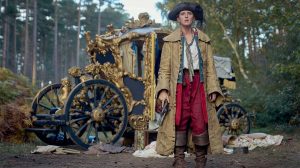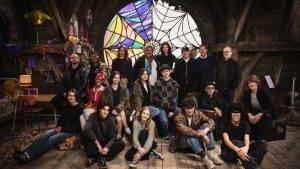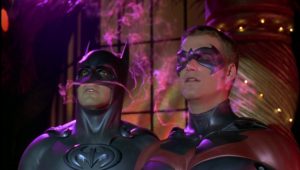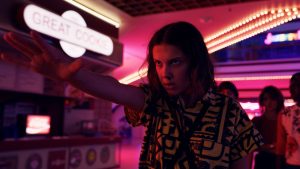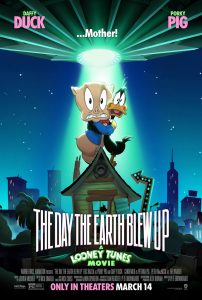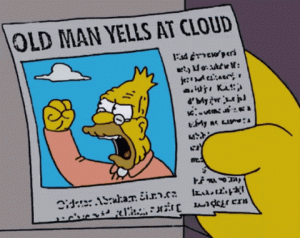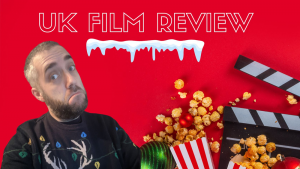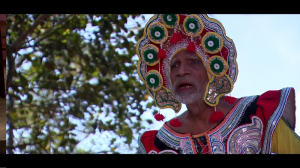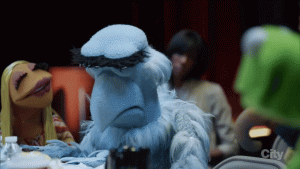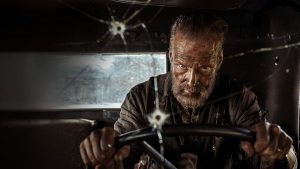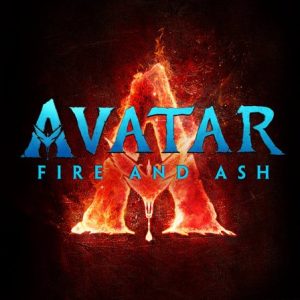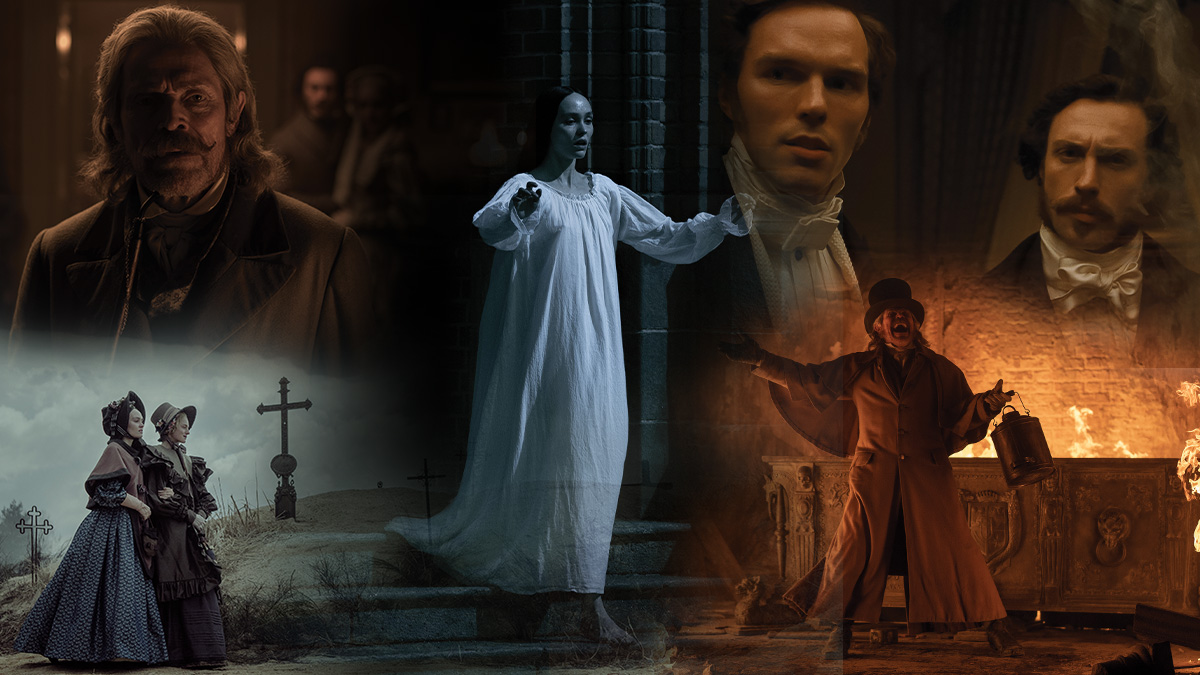
This article appears in the new issue of DEN OF GEEK magazine. You can read all of our magazine stories here.
Bathed in light and shadow, past and present, the castle looming over Robert Eggers and his companions is haunted by its history. It was here, at Pernštejn Castle, that Werner Herzog filmed his reimagining of the German Expressionist classic Nosferatu (1922), and it is here again, more than a hundred years after the original F.W. Murnau masterpiece, that Eggers is attempting to make the most famous vampire story his own.
In a location that actor Nicholas Hoult describes as “cold in terms of a feeling and isolation,” the darkness has been penetrated, too, by upwards of a hundred candles. These rushlights are not intended to be seen in the film, but cinematographer Jarin Blaschke has agreed with Eggers to shoot all the Transylvanian-set scenes exclusively by candlelight—an ambitious task for any vampire movie, much less one captured on celluloid. The bold choice means on another such night, in a dark and shrouded set-build, the first time Hoult and most of the crew will even see Eggers’ vampire, the moldering Count Orlok (an unrecognizable Bill Skarsgård), will be in this dance between light and dark. And every dance has its quirks.
“I had all the prosthetics pieces and the big fur coat,” Skarsgård recalls with a smirk. “And Jarin would have hundreds of candles, and the way he would light a face would just be like, ‘Light more candles; kill these four candles; light those up.’ I remember being very hot and sweaty.” It’s not necessarily the effect one expects in the presence of a vampire, but it was satisfying all the same to Eggers and Skarsgård. After all, the pair have chased the demon for nearly a decade.
Years and years before castle sets, there was a moment when Eggers looked poised to make Nosferatu his second feature following The Witch. The vampire remake was announced in the trades back in 2015, and Eggers fielded immediate interest from many actors, including Skarsgård, who auditioned for several roles before being cast as Thomas Hutter (Hoult’s character in the eventual film). Plans obviously changed, and Eggers went on to make The Lighthouse and The Northman instead, but his vision of a vampire never faltered or shifted. According to Skarsgård, “I don’t think it changed all that much in terms of the dialogue and the structure and the payoff, and how weird and twisted it is, how it’s occult and demonic.”
What did evolve was Eggers’ confidence. Nowadays, the research-intensive filmmaker appears quite comfortable stepping into the shadow of Murnau and Herzog and unearthing something unique in the gloom.
“I don’t know that my intentions were all that different,” Eggers explains, “but I wouldn’t have had the experience and skills to have made it as well as I made it now.”
At last he has found the right moment to unleash an image which has given him no peace: an image of a vampire stripped free from a century’s worth of cinema and fantasy, humor and irony. With a wry smile and small nod to his Lighthouse star Robert Pattinson, Eggers even muses: “We need to find where the fear is in this archetype and bring it out again, and put to bed my friend Rob’s sparkling vampire.”
Raising the Dead
When we catch up with Eggers and his troupe, the singular auteur is in a strange place. The movie he’s dreamed about for so long is finished with the edit locked back in April, yet closure remains elusive. Not until Orlok is out in the world spreading love and pestilence will the experience be complete, and unlike every other Eggers film that was tinkered with until the last minute, the director is getting a chance to catch his breath ahead of Nosferatu’s Christmas Day release. (It’s a date he insists makes total sense: “There’s a Christmas tree in the movie, so what else do you want?”)
At the moment, the director seems content, having fulfilled his goal of going way back with Nosferatu, including to before Murnau and German Expressionism came along. While like the 1922 original, Eggers’ Nosferatu is based on Bram Stoker’s immortal novel Dracula from 1897, the new film is set even earlier than Stoker’s prose, with the movie taking place in 1830s Germany. In this context, Eggers seized on an opportunity to immerse himself in “the learned occult knowledge” of the early 19th century, as well as the older vampire folklore that inspired it.
“Why were people digging up corpses, staking them, cutting their heads off, and burning them?” Eggers posits. “Because they really believed in vampires. Where does that come from? How is that potent?” The filmmaker’s extensive search for an answer took him well into the obsessions of Albin Grau, the producer and production designer on the original Nosferatu who was also a practicing occultist. Eggers went so far as to rename the Van Helsing-like character in the new movie, Albin Eberhart Von Franz (played by Willem Dafoe), after Grau and Jungian psychologist Marie-Louise von Franz. The director’s quest for authenticity likewise led him to retain certain elements of Murnau and Grau’s iconic Orlok design (the talons are still there) while reinterpreting others.
“My main goal was to ask, ‘What would a dead Transylvanian nobleman look like?’” Eggers says. “The hairstyle and all of the clothing, and all the trappings come down to that, and then creating a scary, imposing, masculine vampire rather than a sad vampire, although Bill still adds some needed pathos in a few moments.”
Skarsgård indeed brings a wounded ferocity to the character while vanishing in Orlok’s design. The Swedish actor reveals he would sit for six hours in the makeup chair for full-body prosthetics, which was only the beginning. Since Eggers’ Orlok is supposed to have once been a 1500s sorcerer who survived the grave, Skarsgård felt liberated in other areas.
“There’s no historically accurate accent of what that would sound like anymore,” Skarsgård explains. “He could possibly be Hungarian or he could be Romanian. So I just took little things, idiosyncrasies that they possibly would have, like rolling Rs, without going too Bela Lugosi. It was just finding these little things to anchor it in.”
A Tale as Old as Time
Skarsgård might intentionally avoid Lugosi, but as a lifelong Dracula fan, he notes that Nosferatu follows “one of the greatest horror stories ever told.” It’s a myth Eggers recreates with the care of accursed scripture.
Set in 1838 in the fictional Baltic port city of Wisburg, Nosferatu finds two young lovers, Thomas Hutter (Hoult) and his wife Ellen (Lily-Rose Depp), separated when Thomas gets the offer of a lifetime to sell real estate to an eccentric nobleman in the Carpathians. Viewers might guess where this is headed, but what will be unnervingly new is the psychic, nigh perverse connection that Depp’s Ellen has had with Orlok since childhood. He is a presence that’s always walked beside her, and now he is coming to be with her in the flesh. Unfortunately, he brings with him all the plagues and pestilence of antiquity.
Says Eggers, “One of the things that I like about the Murnau version taking place earlier [than Dracula] is… Dracula is moving to London because it’s one of the hubs of the Western world and he’s eventually hoping for world domination. Whereas Orlok just seems to want Ellen. It therefore becomes a little bit more of a simple fairy tale.”
Simplicity can deceive, though, and one of the most intriguing new complexities of Nosferatu (2024) is that it fully becomes Ellen’s story.
“She’s somebody who’s been plagued with this darkness that’s always been around her,” Depp tells us. “She’s felt this pull since she was a little girl. So I think she felt a lot of shame for it and a lot of loneliness… and she was really calling out for some kind of companionship, and she found it in this demonic force. In Orlok.”
It’s a take on the material that a Dracula aficionado like Depp instantly fell in love with when she read the script, and which she fought to realize on the big screen. In fact, more than a few folks who saw the movie asked Eggers if during the scenes of Ellen’s “convulsions,” when she appears to be communing mentally and physically with the vampire, her contortions were achieved with CGI. Nope. Depp worked with movement choreographer Marie-Gabrielle Rotie to develop each of those scenes during months of prep, finding inspiration in Japanese butoh dance. And even before getting the part, she floored Eggers and his casting director by auditioning, unprompted and over Zoom with her early interpretation of Ellen’s possession.
“I kind of did something totally wild and weird,” she says. “I threw stuff, I threw myself on the ground, I just went nuts.” The director offered her the role the same day.
Building Wisburg Anew
One of the advantages of Nosferatu being the director’s fourth movie is the freedom to finally go big. Larger than any of his previous undertakings, Nosferatu saw the construction of around 60 sets in Prague: massive all-encompassing spaces that recreated a Germany with still one foot in the early-modern era, and a Transylvania that is positively medieval. (The filmmakers also traveled to the real Transylvania for some wide exteriors at Hunedoara Castle.) Eggers says it is “like if Merchant Ivory did a Hammer horror movie.”
The bigger scope similarly frees Eggers to indulge in longer single takes, evocative of 1940s Hollywood, as well as a more heightened way of speaking among the characters. The writer-director points out this is due to the protagonists’ well-to-do standing versus Puritan farmers or Viking warlords. “In the English language, we’re sort of in late Jane Austen, early Charles Dickens, and that gives a different formality to the speech.” As with his previous movies, Nosferatu perennially comes back to the research.
“He’s very good at distilling [history] into the script,” Hoult explains. “That was one of the things I noticed and loved about it. How descriptive it is in terms of era-specific language and moments. It almost feels like you’re reading a novel with dialogue interspersed in.”
Also like other Eggers movies, a commitment to authenticity can lead to adversity. For his part, Hoult remembers filming one sequence in wintertime Prague where, to make the rain visible on candlelit film, he was asked to lie in the mud and beneath a rain machine set to “heavy” in the dead of night. After a few takes of being drenched in ice-cold water, “Rob was very nice and said, ‘You need to warm up,’ because I was shaking violently.”
Depp similarly has a convulsions scene where Ellen falls under a spell while sitting by the sea. Despair over Thomas’ absence transforms into bestial mania. “We started shooting in February, so it was pretty frisky in Prague,” Depp chuckles. “And the water was absolutely freezing… but it’s putting me even more in the circumstance. I don’t have to pretend I’m cold and freaking out. I’m actually cold and freaking out.”
Yet Eggers is quick to note that Nosferatu is less about the physical conditions than the “high stakes” of the emotions endured by the story’s three leads.
Death and the Maiden
More than German Expressionism, it is the aesthetics of great Romantic painters like Johan Christian Dahl and Caspar David Friedrich that inspired Eggers and Blaschke’s visual palette on this one. The film is a lush mix of wintry hues. Even so, the central underlying fear stems from something much older. From Nosferatu’s first scene, the way Orlok stalks Ellen intentionally evokes medieval and early Renaissance motifs: the Danse Macabre, Death and the Maiden, the Daemon Lover. They’re images of death consuming youth. At its base foundational level, it links eroticism and death.
“I just think they’re linked in humanity,” Eggers considers. “Like I don’t think it would take Freud to tell a caveman that when a spear penetrates an animal it is similar to a phallus penetrating a vagina. You pull the spear out. What does it look like? I think that it is just linked, however frightening the idea may be to certain mores, and I think that’s kind of interesting in the horror world.”
In this vein, Depp sees Ellen’s draw toward Orlok as tragic since she is so deeply in love with Thomas. He is genuinely good for her, but there’s something inviting about darkness.
“I think that it touches a lot on taboo and being drawn to something that scares you,” the actress says. “A lot of people live with a true fear of death, understandably so, but we’re kind of drawn to it and intrigued by it… because it’s the most terrifying thing, it’s the most titillating thing.”
Perhaps it is the actor who plays Death himself who can best make sense of Orlok’s thrall. In Skarsgård’s mind, the vampire represents anything humans are drawn to despite knowing better. “It could be an addiction, it could be an abusive relationship, it could be all of those things,” Skarsgård says. “He’s the embodiment and allure of attraction to destruction. Sometimes you want to be destroyed or you want to be corrupted, and that’s Ellen’s inner struggle. Then sometimes, from Orlok’s perspective, it’s the craving to destroy that which you find so beautiful.”
The terror of Nosferatu is we are naturally, and forever, drawn toward it.
Nosferatu opens in theaters on Dec. 25.
The post Nosferatu: Exclusive First Look Inside Robert Eggers’ Reinvention of the Vampire appeared first on Den of Geek.

